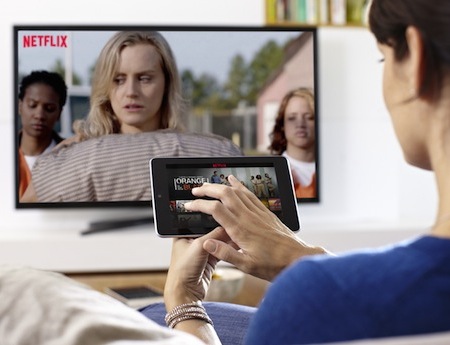SVOD Services in 41% of U.S. Homes

Big changes continue in the way Americans consume television.
In its new Total Audience Report for the fourth quarter of 2014, Nielsen says that 41% of U.S. homes have access to a subscription video-on-demand service like Netflix, up from 36% a year ago.
In homes with streaming services, usage of TV connected technology is nearly 50 minutes greater per day than in a typical TV home.
At the same time, live viewing is down, while delayed viewing rises. And the number of pay-TV subscribers is down while over-the-top services are launched to serve a growing number of broadcast only and broadband only homes.
Changes in viewing behavior have cut into the ratings (and ad revenues) of broadcast and cable networks. Media companies are pushing Nielsen to find more effective ways of measuring viewing on a multiplying number of services and an expanding list of devices. In response Nielsen has set a goal of someday measuring what it calls total audiences.
“Increasing consumer time and attention creates opportunities for content owners. However, economics in digital remain challenging for all but a few. With continued and accelerating fragmentation, the risks and rewards are potentially high, and the ability to stake a claim in the expanding industry pie is central to companies’ growth," said Dounia Turrill, senior VP insights, at Nielsen, who supervised the report. “The landscape has created new competitors—akin to a modern day gold rush—for traditional video and audio, with the emergence of a relatively small number of digital leaders, all of whom are looking not just to compete, but to stake a claim and prosper in that space.”
Turrill said “it will be measurement that holds a key to enabling true understanding of this audience behavior (in real-time) to inform dynamic content and advertising in an ever-fragmenting media world. Accordingly, to do so, audience measurement will transform dramatically to capture and accurately value the ‘total audience.’”
The smarter way to stay on top of broadcasting and cable industry. Sign up below
In the report Nielsen says the amount of time spent per day by adults watching live TV fell to 4 hours and 51 seconds in the fourth quarter, down from 5:04 a year ago and 5:10 in the fourth quarter of 2012. Time-shifted viewing rose to 33 minutes from 32 minutes a year ago and 27 minutes in 2012.
Pay TV households fell to 100.8 million from 102.8 million. Wired cable homes fell to 53.1 million from 55.7 million. Telco homes rose to 13 million from 12 million, satellite homes dipped to 34.7 million from 35.1 million.
The number of broadcast-only homes rose to 12.3 million from 11.3 million. Broadband-only homes more than doubled to 3 million from 1.3 million.
The number of homes with broadcast-only TV access and broadband rose to 6.2 million from 5.6 million and the number of cable homes with broadband access fell to 78.8 million from 79.1 million.
The percentage of homes with a DVR was unchanged at 49%, while the number of homes with SVOD rose to 41% from 36%. The number of homes with a tablet rose to 48% from 36% and the number of homes with enabled smart TVs rose to 14%.
"While we see that this time and attention continues to grow—across devices and services—it also has progressively shifted from live viewing to on-demand consumption with broad-reaching implications,” Turrill said.
“U.S. consumers are adding time to their media day and making time to connect with their favorite content, no matter where it exists. They have the ability to port content—both video content and audio content. Devices and services that enable on-demand access to content, subscription-on-demand services that deliver programming content as well as audio content, are growing by leaps and bounds,” she said.
Jon has been business editor of Broadcasting+Cable since 2010. He focuses on revenue-generating activities, including advertising and distribution, as well as executive intrigue and merger and acquisition activity. Just about any story is fair game, if a dollar sign can make its way into the article. Before B+C, Jon covered the industry for TVWeek, Cable World, Electronic Media, Advertising Age and The New York Post. A native New Yorker, Jon is hiding in plain sight in the suburbs of Chicago.

